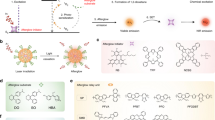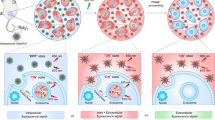Abstract
Optical imaging for biological applications requires more sensitive tools. Near-infrared persistent luminescence nanoparticles enable highly sensitive in vivo optical detection and complete avoidance of tissue autofluorescence. However, the actual generation of persistent luminescence nanoparticles necessitates ex vivo activation before systemic administration, which prevents long-term imaging in living animals. Here, we introduce a new generation of optical nanoprobes, based on chromium-doped zinc gallate, whose persistent luminescence can be activated in vivo through living tissues using highly penetrating low-energy red photons. Surface functionalization of this photonic probe can be adjusted to favour multiple biomedical applications such as tumour targeting. Notably, we show that cells can endocytose these nanoparticles in vitro and that, after intravenous injection, we can track labelled cells in vivo and follow their biodistribution by a simple whole animal optical detection, opening new perspectives for cell therapy research and for a variety of diagnosis applications.
This is a preview of subscription content, access via your institution
Access options
Subscribe to this journal
Receive 12 print issues and online access
$259.00 per year
only $21.58 per issue
Buy this article
- Purchase on Springer Link
- Instant access to full article PDF
Prices may be subject to local taxes which are calculated during checkout






Similar content being viewed by others
References
Aitasalo, T. et al. Persistent luminescence phenomena in materials doped with rare earth ions. J. Solid State Chem. 171, 114–122 (2003).
Matsuzawa, T., Aoki, Y., Takeuchi, N. & Murayama, Y. A new long phosphorescent phosphor with high brightness, SrAl2O4 : Eu2+, Dy3+. J. Electrochem. Soc. 143, 2670–2673 (1996).
le Masne de Chermont, Q. et al. Nanoprobes with near-infrared persistent luminescence for in vivo imaging. Proc. Natl Acad. Sci. USA 104, 9266–9271 (2007).
Maldiney, T. et al. Effect of core diameter, surface coating, and PEG chain length on the biodistribution of persistent luminescence nanoparticles in mice. ACS Nano 5, 854–862 (2011).
Maldiney, T. et al. In vivo optical imaging with rare earth doped Ca2Si5N8 persistent luminescence nanoparticles. Opt. Mat. Express 2, 11810–11815 (2012).
Frangioni, J. V. In vivo near-infrared fluorescence imaging. Curr. Opin. Chem. Biol. 7, 626–634 (2003).
Medintz, I. L., Uyeda, H. T., Goldman, E. R. & Mattoussi, H. Quantum dot bioconjugates for imaging, labelling and sensing. Nature Mater. 4, 435–446 (2005).
Weissleder, R. & Pittet, M. J. Imaging in the era of molecular oncology. Nature 452, 580–589 (2008).
Richard, C. et al. Persistent luminescence nanoparticles for bioimaging. Adv. Intell. Soft Comput. 120, 37–53 (2012).
Wu, B. Y., Wang, H. F., Chen, J. T. & Yan, X. P. Fluorescence resonance energy transfer inhibition assay for α-fetoprotein excreted during cancer cell growth using functionalized persistent luminescence nanoparticles. J. Am. Chem. Soc. 133, 686–688 (2011).
Maldiney, T. et al. Synthesis and functionalization of persistent luminescence nanoparticles with small molecules and evaluation of their targeting ability. Int. J. Pharm. 423, 102–107 (2012).
Maldiney, T. et al. In vitro targeting of avidin-expressing glioma cells with biotinylated persistent luminescence nanoparticles. Bioconjugate Chem. 23, 472–478 (2012).
Jain, R. K. & Stylianopoulos, T. Delivering nanomedicine to solid tumours. Nature Rev. Clin. Oncol. 7, 653–664 (2010).
Danhier, F., Feron, O. & Préat, V. To exploit the tumour microenvironment: Passive and active tumour targeting of nanocarriers for anti-cancer drug delivery. J. Control. Rel. 148, 135–146 (2010).
Al-Jamal, W. T. et al. Tumour Targeting of Functionalized Quantum Dot-Liposome Hybrids by Intravenous Administration. Mol. Pharm. 6, 520–530 (2009).
Park, J. H. et al. Biodegradable luminescent porous silicon nanoparticles for in vivo applications. Nature Mater. 8, 1–6 (2009).
Maldiney, T. et al. Controlling electron trap depth to enhance optical properties of persistent luminescence nanoparticles for in vivo imaging. J. Am. Chem. Soc. 133, 11810–11815 (2011).
Lecointre, A. et al. Designing a red persistent luminescence phosphor: The example of YPO4: Pr3+, Ln3+ (Ln = Nd, Er, Ho, Dy). J. Phys. Chem. C 115, 4217–4227 (2011).
Maldiney, T. et al. Trap depth optimization to improve optical properties of diopside-based nanophosphors for medical imaging. Proc. SPIE 8263, 826318 (2012).
Bessière, A. et al. ZnGa2O4:Cr3+: a new red long-lasting phosphor with high brightness. Opt. Express 19, 10131–10137 (2011).
Pan, Z., Lu, Y. Y. & Liu, F. Sunlight-activated long-persistent luminescence in the near-infrared from Cr3+-doped zinc gallogermanates. Nature Mater. 11, 58–63 (2012).
Abrams, B. L. & Holloway, P. H. Role of the surface in luminescent processes. Chem. Rev. 104, 5783–5802 (2004).
Hirano, M., Imai, M. & Inagaki, M. Preparation of ZnGa2O4 spinel fine particles by the hydrothermal method. J. Am. Ceram. Soc. 83, 977–979 (2000).
Zhang, X. et al. Photocatalytic decomposition of benzene by porous nanocrystalline ZnGa2O4 with a high surface area. Envir. Sci. Tech. 43, 5947–5951 (2009).
Bessière, A. et al. Storage of visible light for long-lasting phosphorescence in chromium-doped zinc gallate. Chem. Mater. 26, 1365–1373 (2014).
Castano, A. P., Demidova, T. N. & Hamblin, M. R. Mechanisms in photodynamic therapy: part one—photosensitizers, photochemistry and cellular localization. Photodiagn. Photodynam. Therapy 1, 279–293 (2004).
Mikenda, W. & Preisinger, A. N-lines in the luminescence spectra of Cr3+-doped spinels: II Origins of N-lines. J. Lumin. 26, 67–83 (1981).
Nie, W., Michel-Calendini, F. M., Linares, C., Boulon, G. & Daul, C. New results on optical properties and term-energy calculations in Cr3+-doped ZnAl2O4 . J. Lumin. 46, 177–190 (1990).
Yukihara, E. G. & McKeever, W. S. Optically Stimulated Luminescence: Fundamental and Applications (John Wiley, (2011).
Derkosch, J & Mikenda, W. N-lines in the luminescence spectra of Cr3+-dopd spinels IV excitation spectra. J. Lumin. 28, 431–441 (1983).
Brito, H. F. et al. Persistent luminescence mechanisms: human imagination at work. Opt. Mater. Exp. 2, 371–381 (2012).
Dorenbos, P. Mechanism of persistent luminescence in Eu2+ and Dy3+ codoped aluminate and silicate compounds. J. Electrochem. Soc. 152, H107–H110 (2005).
Walkey, C. D., Olsen, J. B., Guo, H., Emili, A. & Chan, W. C. W. Nanoparticle size and surface chemistry determine serum protein adsorption and macrophage uptake. J. Am. Chem. Soc. 134, 2139–2147 (2012).
Daou, T. J., Li, L., Reiss, P., Josserand, V. & Texier, I. Effect of poly(ethylene glycol) length on the in vivo behavior of coated quantum dots. Langmuir. 25, 3040–3044 (2009).
Schipper, M. L. et al. Particle size, surface coating, and pegylation influence the biodistribution of quantum dots in living mice. Small 5, 126–134 (2009).
Ishida, O., Maruyama, K. & Sasaki, K. Size-dependent extravasation and interstitial localization of polyethyleneglycol liposomes in solid tumour-bearing mice. Int. J. Pharm. 190, 49–56 (1999).
Poon, Z., Lee, J. B., Morton, S. W. & Hammond, P. T. Controlling in vivo stability and biodistribution in electrostatically assembled nanoparticles for systemic delivery. Nano Lett. 11, 2096–2103 (2011).
Cho, E. C., Xie, J., Wurm, P. A. & Xia, Y. Understanding the role of surface charges in cellular adsorption versus internalization by selectively removing gold nanoparticles on the cell surface with a I/KI etchant. Nano Lett. 9, 180–184 (2009).
Walkey, C. D., Olsen, J. B., Guo, H., Emili, A. & Chan, W. C. W. Nanoparticle size and surface chemistry determine serum protein adsorption and macrophage uptake. J. Am. Chem. Soc. 134, 2139–2147 (2012).
Fidler, I. J. Biological behavior of malignant melanoma cells correlated to their survival in vivo biological behavior of malignant melanoma cells correlated to their survival in vivo. Cancer Res. 35, 218–224 (1975).
Hewitt, G. et al. Telomeres are favoured targets of a persistent DNA damage response in ageing and stress-induced senescence. Nature Commun. 3, 1–9 (2012).
Kruk, P. A., Rampino, N. J. & Bohr, V. A. DNA damage and repair in telomeres: Relation to aging. Proc. Natl Acad. Sci. USA 92, 258–262 (1995).
Acknowledgements
We thank R. Lai-Kuen and B. Saubamea (from the Technical Platform of IFR71/IMTCE–Cellular & Molecular Imaging), L. Binet (for electron paramagnetic resonance experiments), K. R. Priolkar and N. Basavaraju (for bulk ZGO samples), C. Charrueau and N. Neveux (for biomarker dosage) and S. Maitrejean (for ZGO and QD experiment comparison). This work has been supported by the French National Agency (ANR) (NATLURIM project ANR-08-NANO-025) and IFCPAR/CEFIPRA (Indo-French Center for the Promotion of Advanced Research).
Author information
Authors and Affiliations
Contributions
T.M., B.V., D.G., D.S. and C.R. conceived and designed the research. T.M., J.S., E.T. and S.K.S. carried out the experiments. T.M., J.S., E.T. and D.S. were responsible for biological characterization and small animal in vivo imaging. T.M., A.B., S.K.S., B.V. and D.G. were responsible for optical and TSL characterization and mechanism, A.J.J.B. and P.D. were responsible for the TSL excitation spectra. All of the authors analysed the data and discussed the results. T.M., A.B., B.V., D.G., D.S. and C.R. wrote the manuscript. The authors declare no conflict of interest.
Corresponding authors
Ethics declarations
Competing interests
The authors declare no competing financial interests.
Supplementary information
Supplementary Information
Supplementary Information (PDF 2032 kb)
Rights and permissions
About this article
Cite this article
Maldiney, T., Bessière, A., Seguin, J. et al. The in vivo activation of persistent nanophosphors for optical imaging of vascularization, tumours and grafted cells. Nature Mater 13, 418–426 (2014). https://doi.org/10.1038/nmat3908
Received:
Accepted:
Published:
Issue Date:
DOI: https://doi.org/10.1038/nmat3908
This article is cited by
-
Charge trapping for controllable persistent luminescence in organics
Nature Photonics (2024)
-
SrHfO3:Cr3+ Perovskite Microcubes for Rare-Earth-Free NIR-I Light Emission
Journal of Electronic Materials (2024)
-
Controlling persistent luminescence in nanocrystalline phosphors
Nature Materials (2023)
-
Intervalence charge transfer of Cr3+-Cr3+ aggregation for NIR-II luminescence
Light: Science & Applications (2023)
-
New opportunities and old challenges in the clinical translation of nanotheranostics
Nature Reviews Materials (2023)



